 |
|
|
|
|
 How To Solve Puzzles
How To Solve Puzzles
How to Solve KenKen® Puzzles
by Roy Leban
If you like Sudoku, there’s a good chance you’ll love KenKen. If you hate Sudoku, there’s a good chance you’ll love KenKen. Invented by Japanese mathematics teacher Tetsuya Miyamoto in 2004, KenKen is an elegant and rich logic puzzle with a few easy-to-understand rules, which helps explain why New York Times Puzzle Editor Will Shortz called it “The most addictive puzzle since Sudoku.”
KenKen’s rules are straightforward:
- Fill in each square cell in the puzzle with a number between 1 and the size of the grid. For example, in a 4×4 grid, use the numbers 1, 2, 3, & 4.
- Use each number exactly once in each row and each column.
- The numbers in each “Cage” (indicated by the heavy lines) must combine — in any order — to produce the cage’s target number using the indicated math operation. Numbers may be repeated within a cage as long as rule 2 isn’t violated.
- No guessing is required. Each puzzle can be solved completely using only logical deduction. Harder puzzles require more complex deductions.
Solving Techniques
Here’s a sample puzzle that we’ll use to illustrate solving techniques:
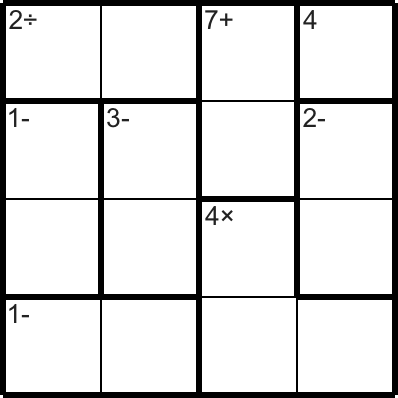
Each cage in a KenKen contains a target number and most contain an operator. If you see a single-cell cage with just a number and no operator, it means that the value in that cell is the target number. Such single-cell cages work like givens in Sudoku puzzles. You won’t see these in every puzzle, but when you do see one, you should start there. In this puzzle, we can immediately place a 4 in the upper right cell:
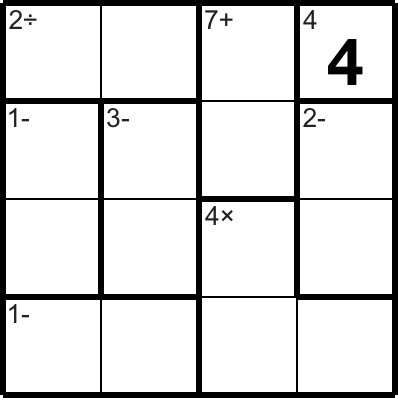
Whenever we place a number, this narrows down the possibilities for other cells, so we want to look for that. In this puzzle, we know that the 7+ cage in the third column must contain 3 & 4, since that is the only possibility that adds to 7. Given the 4 that we just placed, combined with the rule that we must use each number exactly once in each row and each column, we can now tell which of the cage’s cell contains a 3 and which contains a 4:
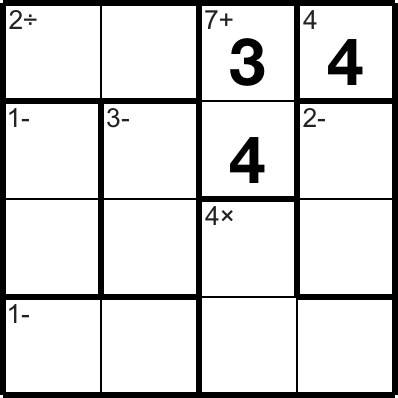
We can now tell that the two empty cells in the third column (in the 4× cage) contain 1 & 2, but we don’t know the order. However, given that information, we can place a 2 in the lower right cell to make the cage’s product be 4:
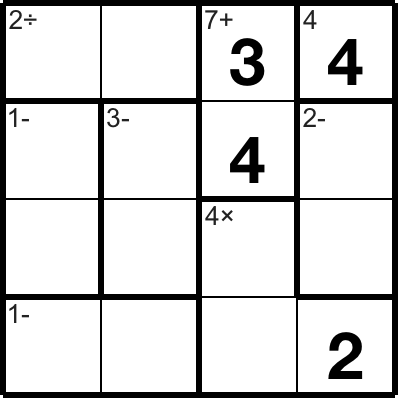
Remember that a cage can repeat numbers in an irregularly shaped cage as long as no number is duplicated within a single row or column. In this puzzle, before we knew the two values in the 7+ cage, we didn’t know if the 4× cage contained the numbers 1, 1, & 4 or 1, 2, & 2. Now that we know about the 2, we can immediately finish the 4× cage because we know the second 2 must be in the third row:
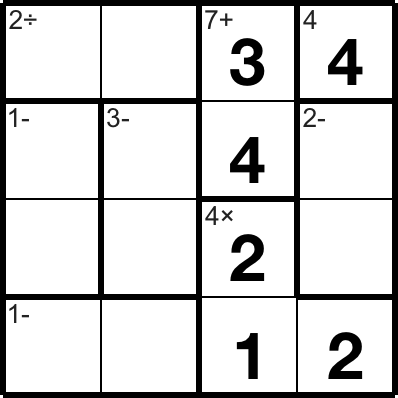
For more complex deductions, it can be useful to take notes in the puzzle, which you can do by using the right side of the on-screen keyboard, holding down the Shift key while typing on a physical keyboard, or switching to Pencil input with TouchWrite. In the 2÷ cage in the upper left, there are only two possibilities — 1 & 2 or 2 & 4. The latter is excluded by the 3 & 4 already in the row, so we can deduce that two cells contain 1 & 2 (in an unknown order). Since knowing this doesn’t let us place any additional numbers immediately, we can use notes to help us remember it for future use.
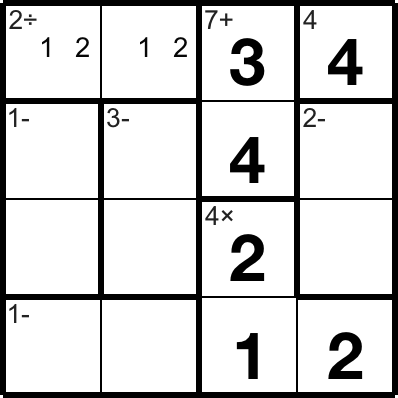
Next, we can look at the 1- cage in the first column. Without knowing any constraints, the cells can contain 1 & 2 or 2 & 3 or 3 & 4. But our notes show us that the first column will already contain either a 1 or 2, which means the 1- cage cannot contain 1 & 2. This means it must have either 2 & 3 or 3 & 4. Whichever it is, it means the 1- cage will definitely contain a 3. And that means the bottom left cell cannot be a 3, which means it must be a 4:
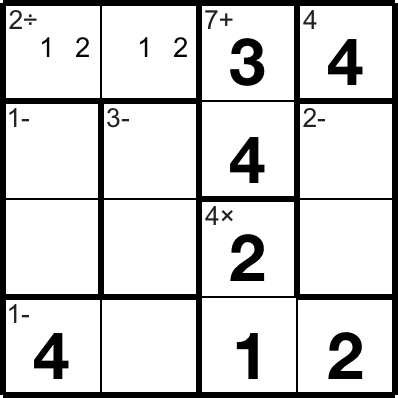
That also lets us place the 3 in the bottom row and then the 4 in the second row tells us how to place the 1 and the 4 above it:
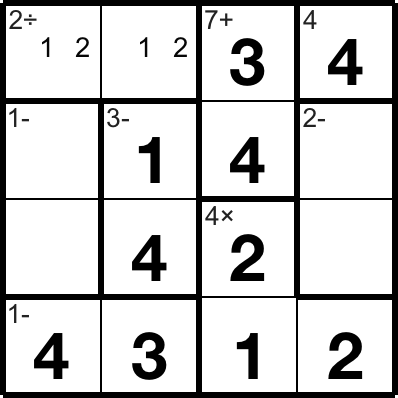
Now we can place the 2 and then the 1 in the top row:
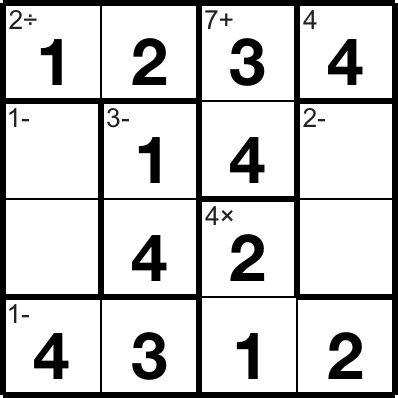
Next, we finish up the first column, and we can tell the order because the third row already has a 2 in it:
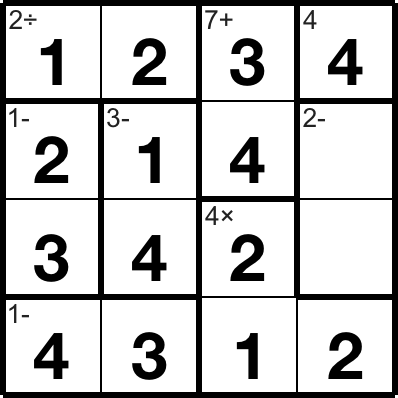
Finally, we wrap up the puzzle by placing the last two numbers in the fourth column:
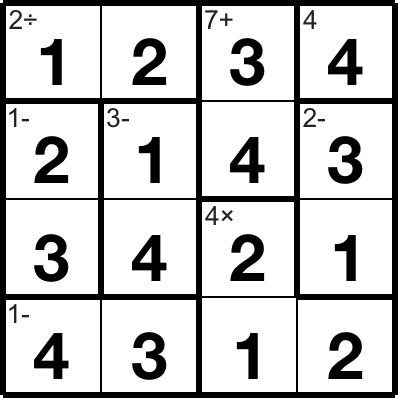
Hints
If you’re just getting started with KenKen puzzles, don’t forget you can get hints.
Just tap on the  icon to fill in a value or remove mistakes.
icon to fill in a value or remove mistakes.
KenKen® is a registered trademark of KenKen Puzzle LLC. All rights reserved. www.kenkenpuzzle.com.



|
Our Puzzle Books Buy Gift Certificates
Our World-Class Authors
How to Solve Puzzles
Our exclusive, award-winning TouchWrite™ handwriting recognition
Special features: Puzzles Live 2013 100th Anniversary of the Crossword
Get the puzzle of the day:
Read the latest Puzzazz Newsletter
About Us Contact Us Support FAQ Read the Buzz about Puzzazz
Your account Redeem a coupon or special offer
Cookies: If you sign in, we use a cookie for that purpose. We also use cookies to manage your browser session.
If you use third-party services, such as Facebook, with Puzzazz, they may use cookies following their own policies.
© 2025 Puzzazz Privacy Policy



